Fairmont Normal School / Fairmont Political Equality Club
Introduction
Text-to-speech Audio
This was the second location of the Fairmont Normal School, operating from 1893 to 1916. Fairmont Normal School provided training and degree programs for K-12 teachers and eventually moved to its third location, which is now Fairmont State University on Locust Avenue. On November 28, 1895, the Fairmont Political Equality Club was organized at Fairmont Normal School. The Fairmont Political Equality Club was one of the most active and long-lasting suffrage clubs in West Virginia.
Images
Fairmont Normal (West Virginia & Regional History Center)
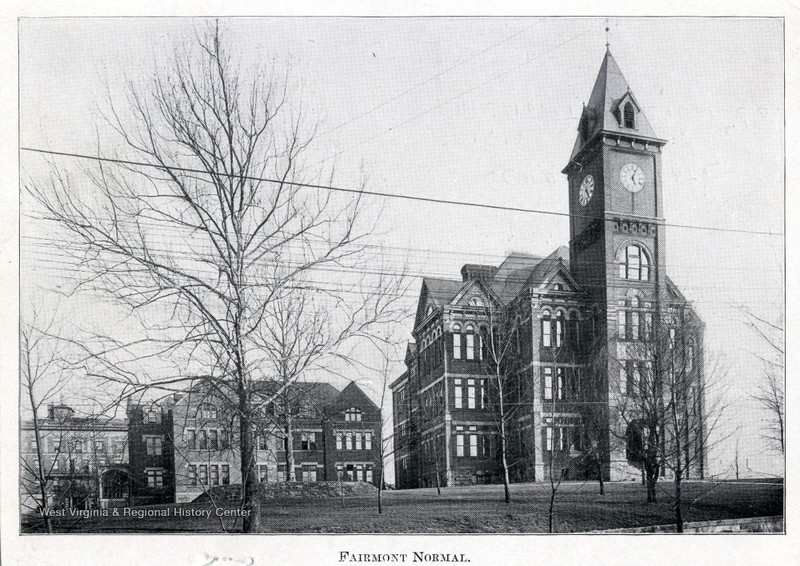
Fairmont Normal School (West Virginia & Regional History Center)
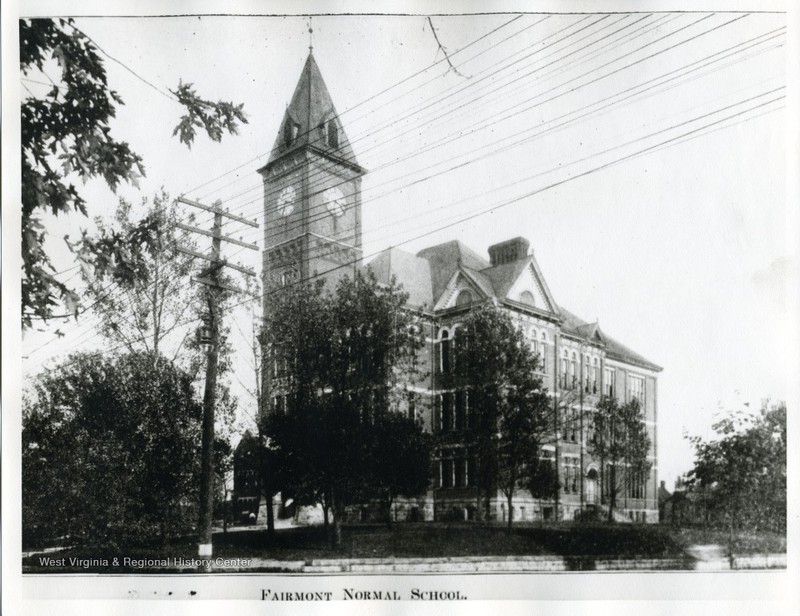
The Fairmont Normal School on a 1897 map of Fairmont and Palatine
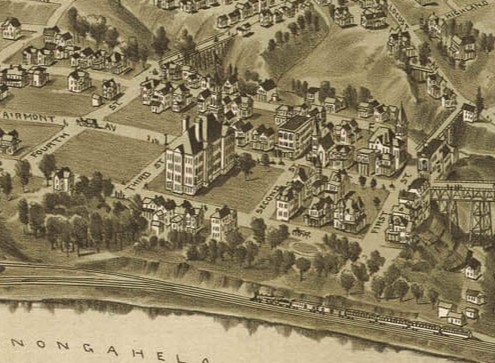
"View of Fairmont, West Virginia from Hamilton's Hill. Homes and businesses of Fairmont are bounded by the Monongahela River on the right side of the photograph. Fairmont Normal School building is the tall building in the upper center of the image."
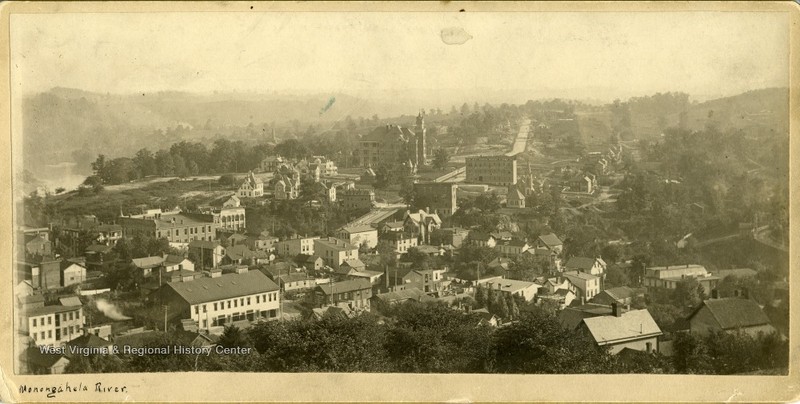
Fairmont State Normal School Campus (West Virginia & Regional History Center)

Students in front of Fairmont Normal School, 1915
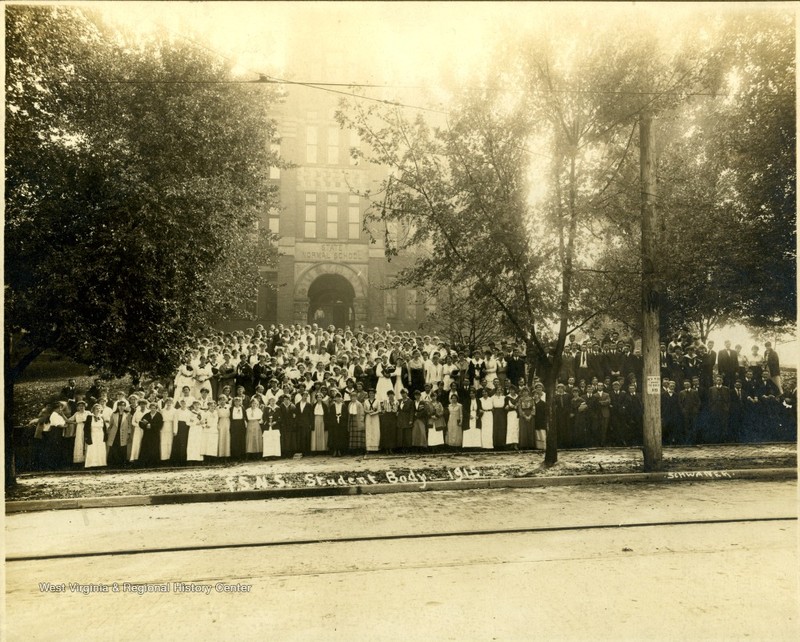
Postcard of Fairmont Normal School
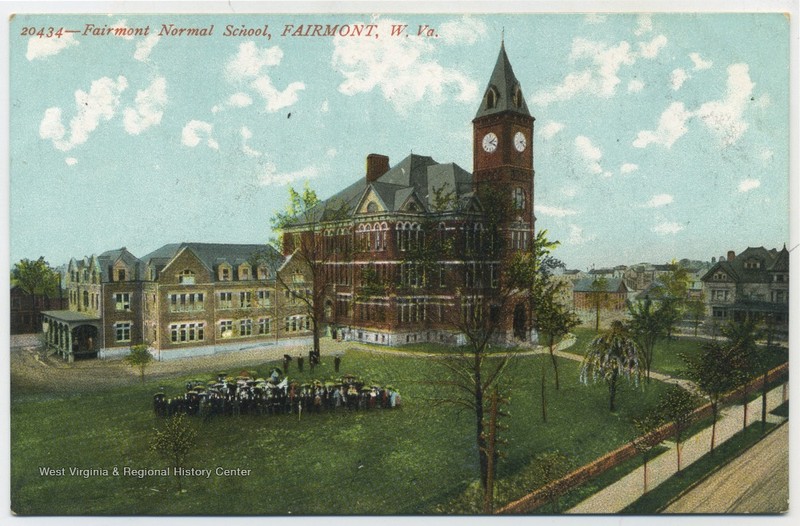
Postcard of the Dormitory side of the Normal School
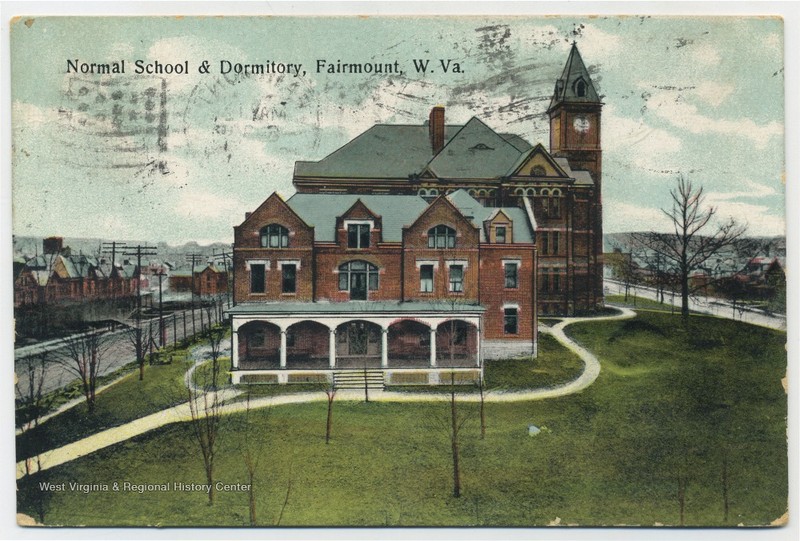
Postcard of Fairmont Normal School
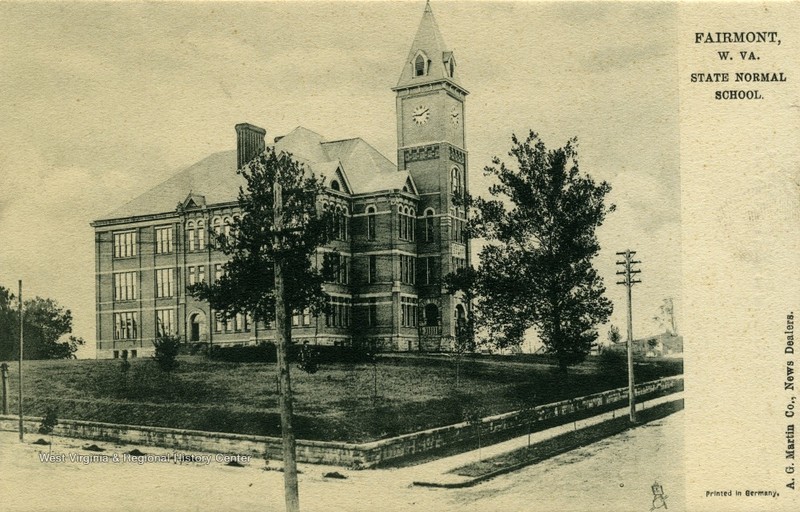
Postcard, Girls Dormitory
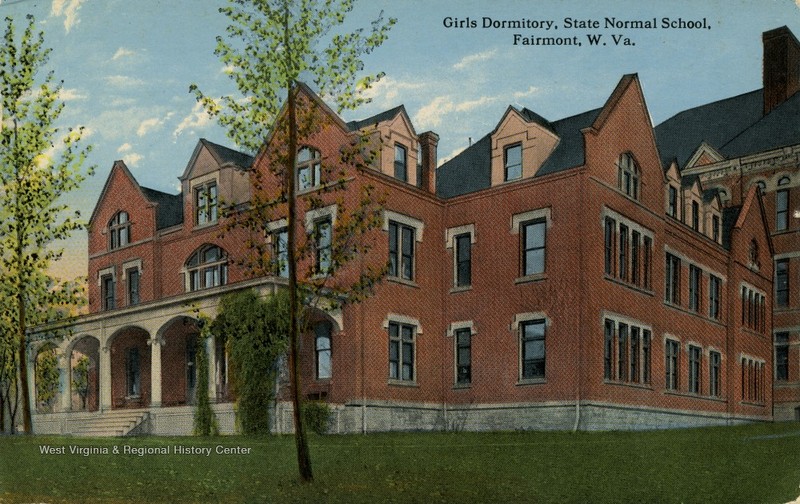
Ladies Dormitory and Normal School, postcard c. 1906
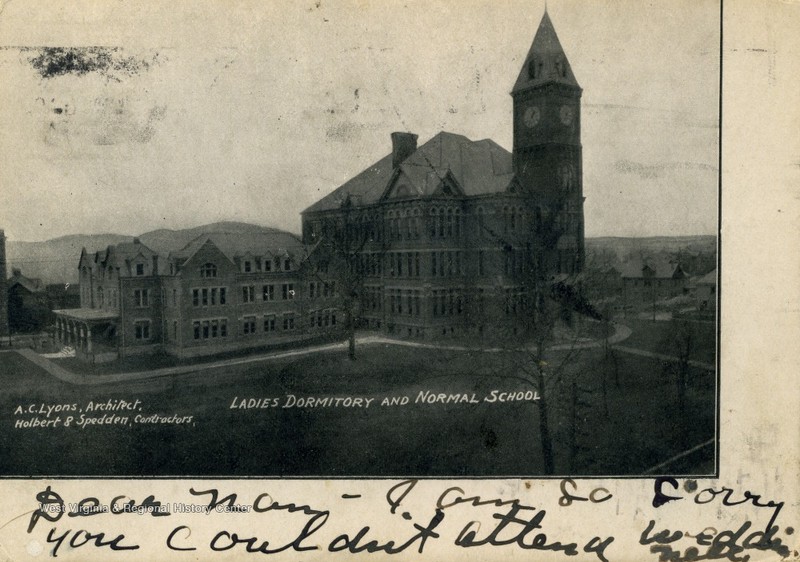
Jessie G. Manley was present at the founding meeting of the Fairmont Political Equality Club, and was the 1st president of the West Virginia Equal Suffrage Association. Her mother, Margaret J. Grove, was the 1st president of the Fairmont Political Equality Club.
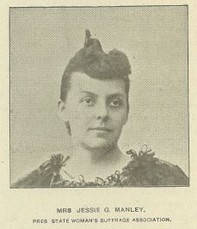
Example of Fairmont Political Equality Club activities, from The Fairmont West Virginia, March 9, 1914
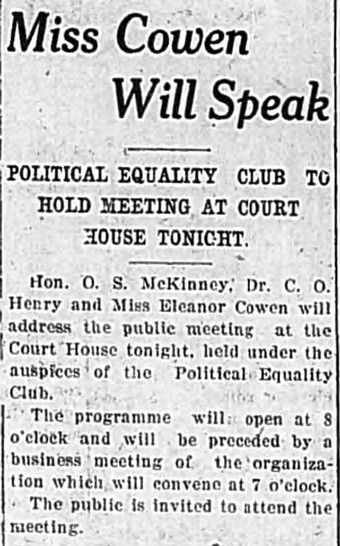
Backstory and Context
Text-to-speech Audio
Normal Schools typically trained teachers, offering two years of study for elementary teachers and a four-year baccalaureate degree for secondary instructors. The Fairmont Normal School started operating in 1865 in the basement of the Methodist Protestant Church on Quincy Street and by 1867 West Virginia partially funded the construction of a new building. The school became an official branch of the Normal School at Marshall College in 1868 and the new school building on Quincy Street opened in 1869, with a further expansion on Adams Street in 1873. At this first location, the Normal School operated in the same buildings as K-12 classes until the 1890s. By 1892 the student enrollment had expanded enough that the Normal School needed a separate building. The Adams Street building transferred over to the Fairmont School District while the Normal School constructed their second site on Fairmont Avenue.
The State purchased two-acres from the Fairmont Development Corporation on the 200 block of Fairmont Avenue and constructed a three-story, red brick building with a large tower designed by O. S. Philpott. Fairmont Normal School relocated to the new location in March 1893. Now that the school operated from ins own building, the Fairmont Normal School formalized their programs to allow students to focus on training in a particular subject, added athletic programs, and added a “model school” to allow for student teacher experience in a classroom. Between 1892 and 1912 the school enrolled an average of 380 students, but enrollment increased into the 500s by 1915. With no more room to expand on their current plot of two-acres, the state started looking for a new property for the school’s third location.
This second relocation process started in 1912 when the West Virginia State Legislature authorized the sale of the Fairmont Avenue location and purchased 12 acres on Locus Avenue. Construction of the new location (now Fairmont State University) began in 1914 and the official relocation occurred in January 1917. After Fairmont Normal School relocated to Locust Avenue, the Fairmont Ave building was used for a short time as a business school and the dorm was used temporarily by Cook Hospital for student nurse housing. The building was demolished in 1924, except for the Normal clock tower that was transferred to an addition to East Side High School. The clock tower was damaged in 1965 and taken down, but the bell is still on display in front of the school.
Fairmont Political Equality Club, founded November 28, 1895 at Fairmont Normal
On November 28, 1895, women and a few men met at the Fairmont Normal School to organize a suffrage club. This was a consequence of efforts by the National American Woman Suffrage Association (NAWSA) to spur a women’s suffrage movement in West Virginia. By 1895, West Virginia was one the few states in the country that had no organized movement for suffrage equality and the NAWSA sent Rev. Henrietta G. Moore to do a series of speaking engagements in West Virginia to increase interest. After Moore’s tour, West Virginia women gathered at the end of November for the first women’s suffrage convention in Grafton and nine suffrage clubs were organized in the northern counties of the state, including Fairmont’s.
According to a recollection by Elizabeth Stone, the attendees at the November 28th meeting were rather timid in proclaiming support for suffrage. The speaker of the night was Anna Dregs of Kansas and no one seemed willing to introduce the speaker, or handle other elements of the meeting, due to fear of censure from other members of the community. Hon. Bernard L. Butcher finally introduced the speaker and Jessie G. Manley and Beulah Boud Ritchie handled collecting donations.
Despite this hesitant beginning, the Fairmont Political Equality Club ended up being one of the most long-lasting and active suffrage clubs in West Virginia. Forty-four people made up the original charter group and Margaret J. Grove served as the organization’s first president. The second woman’s suffrage convention was held in Fairmont in 1897 and by that year only two of the original nine suffrage clubs remained. The Fairmont Political Equality Club typically met monthly to hear speakers and discuss the movement, including funding a visit by Rev. Anna Howard Shaw to speak before the West Virginia State Legislature in 1899. As the West Virginia suffrage movement dwindled after 1900, the Fairmont club remained the only active suffrage club in the state for a period of time and it served as a leader for the revival of the movement in West Virginia around 1909.
Sources
Alvarez, M. Raymond. “Fairmont Normal School: Recalling People and Progress from 1868-1916.” Fairmont Normal School History: Fairmont State Normal School. Fairmont State University Library. Accessed January 11, 2022. https://library.fairmontstate.edu/ld.php?content_id=61038787
Alvarez, Raymond. “The Normal on the Avenue: Recalling People, Progress and Panache of Fairmont Normal School’s Southside Campus.” Fairmont Normal School History: Fairmont State Normal School. Fairmont State University Library. Accessed January 11, 2022. https://library.fairmontstate.edu/ld.php?content_id=61029150
Effland, Anne Wallace. “The Woman Suffrage Movement in West Virginia, 1867-1920.” M. A. Thesis, West Virginia University, 1983.
“Fighting the Long Fight: West Virginia Women and the Right to Vote.” A West Virginia Archives and history Online Exhibit. West Virginia Archives & History. http://129.71.204.160/history////exhibitsonline/suffrage/suffrageintroductiontoc.html
Stone, Elizabeth. “Fairmont Women Among the First to Come Out Openly for the Equal Suffrage Cause.” The West Virginian. August 19, 1920. Fighting the Long Fight: West Virginia Women and the Right to Vote. A West Virginia Archives and History Online Exhibit. Accessed January 12, 2022. http://129.71.204.160/history////exhibitsonline/suffrage/suffragefairmontgroup.html.
"Fairmont State Normal School, Fairmont, W. Va." West Virginia History OnView. West Virginia & Regional History Center. Accessed January 11, 2022. https://wvhistoryonview.org/catalog/005769.
"Fairmont State Normal School, Fairmont, W. Va." West Virginia History OnView. West Virginia & Regional History Center. Accessed January 11, 2022. https://wvhistoryonview.org/catalog/005785.
"Historic Map - Fairmont & Palantine, WV - 1897." World maps Online. Accessed January 11, 2022. https://www.worldmapsonline.com/historic-map-fairmont-palatine-wv-1897/.
"Fairmont, W. Va. - View from Hamilton's Hill." West Virginia History OnView. West Virginia & Regional History Center. Accessed January 11, 2022. https://wvhistoryonview.org/catalog/005809.
"Fairmont State Normal School Campus, Fairmont, W. Va." West Virginia History OnView. West Virginia & Regional History Center. Accessed January 11, 2022. https://wvhistoryonview.org/catalog/026091.
"Student Body of Fairmont Normal School, Fairmont, W. Va." West Virginia History OnView. West Virginia & Regional History Center. Accessed January 11, 2022. https://wvhistoryonview.org/catalog/026522.
"Fairmont Normal School; Fairmont, W. Va." West Virginia History OnView. West Virginia & Regional History Center. Accessed January 11, 2022. https://wvhistoryonview.org/catalog/042907.
"Normal School & Dormitory; Fairmont, W. Va." West Virginia History OnView. West Virginia & Regional History Center. Accessed January 11, 2022. https://wvhistoryonview.org/catalog/042909.
"State Normal School; Fairmont, W. Va." West Virginia History OnView. West Virginia & Regional History Center. Accessed January 11, 2022. https://wvhistoryonview.org/catalog/042974.
"Girls Dormitory, State Normal School; Fairmont, W. Va." West Virginia History OnView. West Virginia & Regional History Center. Accessed January 11, 2022. https://wvhistoryonview.org/catalog/042977.
"Ladies Dormitory and Normal School, Fairmont, W. Va." West Virginia History OnView. West Virginia & Regional History Center. Accessed January 11, 2022. https://wvhistoryonview.org/catalog/045346.
"West Virginia Equal Suffrage Association." Wikipedia. Accessed January 12, 2022. https://en.wikipedia.org/wiki/West_Virginia_Equal_Suffrage_Association.
"Miss Cowen Will Speak." The Fairmont West Virginia. Newspapers.com. Accessed January 12, 2022. https://www.newspapers.com/clip/22207892/the-fairmont-west-virginian/.
